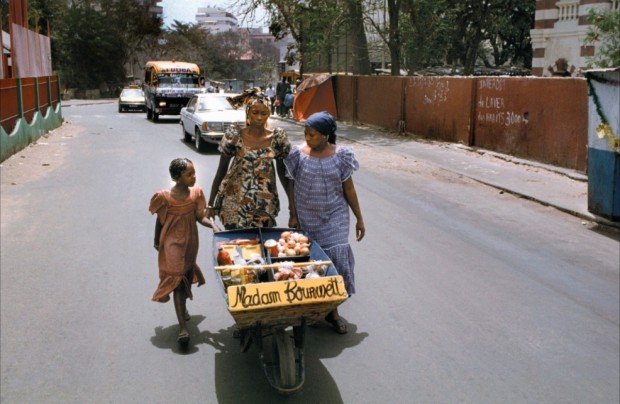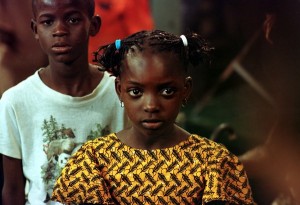You have no items in your cart. Want to get some nice things?
Go shopping
In 2009, the film critic Danny Leigh wrote a fantastic piece in the Guardian film blog on the lack of African films enjoyed in British cinemas. It doesn’t seem that much has changed since then. Outside a few niche audiences, films from the African continent have largely been ignored by mainstream UK audiences—unless we count Meryl Streep (and that bizarre Danish accent) in Out of Africa. So when I had the opportunity, I enthusiastically scooted off to the Africa Centre in Covent Garden, which often has free screenings of African films, to watch a contemporary classic of Senegalese cinema, Madame Brouette. Away from the bustling crowds of shoppers in Covent Garden, I found myself transported from the cold, wet streets of London to the vivid, dusty shantytowns of Western Africa.
Madame Brouette (2002), by Moussa Sene Absa, is a beautiful and searing comic drama set in the city of Dakar, Senegal. Opening on a scene of carnival celebration, the camera centres on the film’s female characters as they enter an urban square dressed in elaborate yellow costumes, led by the tall and gracious figure of Mati, known as Madame Brouette. While men sit around the periphery, the music starts up and the women begin their wild communal dance in a joyful frenzy of yellow as the titles roll.
It is an opening sequence which introduces many of the themes which run throughout this film. Speaking on his films generally, Absa has said, “I am not trying to amuse people; I am trying to transform them . . . the role of the artist in society is to provoke.” With sometimes comic and surreal moments, it deals with weighty themes of love, oppression, corruption, freedom, money and death with a lyrical melodrama which feels in league with Baz Luhrmann’s Romeo and Juliet (1996). While illuminating a very contemporary society, the film has the essence of a Greek tragedy. A chorus appears at certain points, which brings musical punctuation to the drama and a running commentary to the unfolding action.
At its heart this film is about the strength and solidarity of women. Without being dry or overtly didactic, the film addresses the role of women in modern Senegalese society and the perpetual recurrence of these struggles in the country’s history. At the centre of the story is the beguiling heroine Mati, who supports herself and her daughter Ndèye by selling goods from her wheelbarrow around the streets of the city. Equally beautiful and independent, she is marked out from the world around her by her looks and opinions, announcing that she has given up on men and the traditional confines of marriage in search of freedom. Her public name, “Madame Brouette” (Mrs Wheelbarrow), presents her not as a wife but as entrepreneur. Early in the film she encourages her friend Ndaxté to leave her abusive husband with the dream of co-owning a canteen and making a better life.
The friendship of Ndaxté and Mati is incredibly vivid and a constitutive element of the film’s narrative. But the independence of these women is seen almost as an act of hubris, which outside factors seek to corrupt. Apart from being a poignant symbol of her hard work and strength, Mati’s colourful wheelbarrow comes to be the source of her vulnerability as a woman. Despite swearing off men, she meets and falls in love with a local policeman, Naago, whom she distrusts but cannot resist. Naago is as charming as he is corrupt, seen to be in the pocket of local crooks and pimps. He quickly gets Mati pregnant and then leaves her stranded. With little help from others Mati and Ndaxté work to fulfil their dreams and eventually set up their canteen, but even as she seeks to live independently, she repeatedly goes back to Naago, unable to truly separate from him.

Throughout the story, Mati’s character is connected with the symbol of the partridge, both by the song of the chorus and the bird which hangs in a cage outside their house. Absa explains that, “for me the woman is sacred. I compare her to a partridge. In the days of royal courts, the partridge was a sacred animal, used in mystical practices because it brought luck and happiness. This bird could not be eaten by just anyone. You had to deserve it. Like a woman. You must deserve her.” Madame Brouette venerates the strength and self-sufficiency of women from within the male-dominated society of Senegal. Women are depicted like the bird in the cage, seeking liberation and freedom, while men fight to maintain their dominance. Absa’s veneration of the ‘sacred’ woman could be seen as patronising or idealising, but instead, the gritty reality of this film shows women, not on a pedestal but in the street grafting for a small dream. Mati is not a perfect woman, but she is a woman who should be admired.
This film provoked, shocked, entertained and beguiled me with its beautiful and heart-breaking story. Rokhaya Niang is captivating as the powerful Mati, but it is Ndeye Seneba Seck, playing her daughter, who steals the screen with her wilful charm despite the situation around her. These characters, the vivid and colourful cinematography and a comic slight-of-hand lure you in, before stabbing you in the heart. Madame Brouette is a woman trying to empower herself and rise above her situation, but a fatal capacity for love appears to be her downfall. Considering this, the song sung by the chorus as the film closes is both comforting and ironic:
“Hear this ode, beautiful woman! You see, I am your mother. Your tears banish my joy. Now come, take your first steps in life. Wealth may disappear one day, but love is eternal. So come, take refuge in my arms.”
It is this tragic flaw of love which Absa almost presents as a universal, timeless reality of this narrative, and of the situation of women in this region of West Africa. Even as a male director, Moussa Sene Absa deftly mediates these complex themes which transcend the screen to make strong statements about the situation of women in Senegal. I defy you not to be moved. Brouette is a real testament to the importance of African cinema, and why there should be more chances to see it in British cinemas.
The “Africa on Film” series continues at the Africa Centre in Covent Garden with Viva Rica (2010) on 13th January. Entry is free. To register your place visit the website.

About Bea Moyes
Bea is currently studying for an MRes at the London Consortium, Birkbeck. She is a writer and researcher involved in exploring the poetics and cultural history of urban spaces, with a particular passion for yarnbombing and temporary street installations. Until summer 2012 Bea was director and curator of short stories at the digital publisher Ether Books and has worked with a number of publishers as well as for literary publicists and magazines.





I really enjoyed this, Bea. It does what all good reviews should do—give away just enough but not too much, and talks about it in a way that makes me want to go and watch the film (and not simply because it’s recommended viewing!)
Very insightful and apt to highlight key areas.